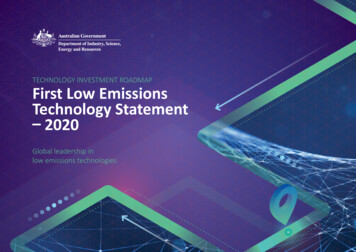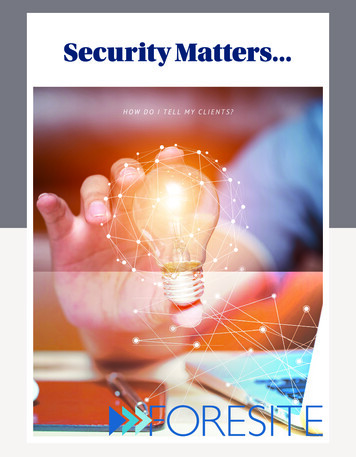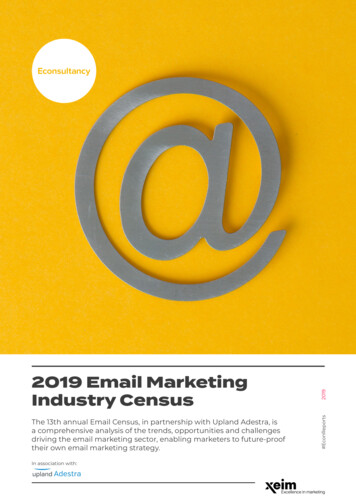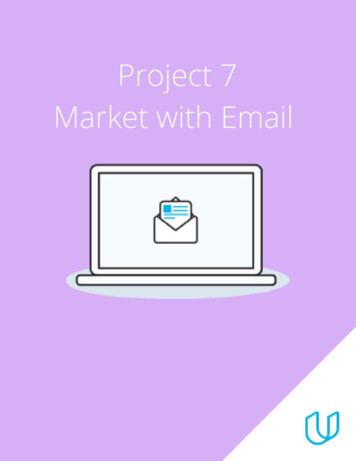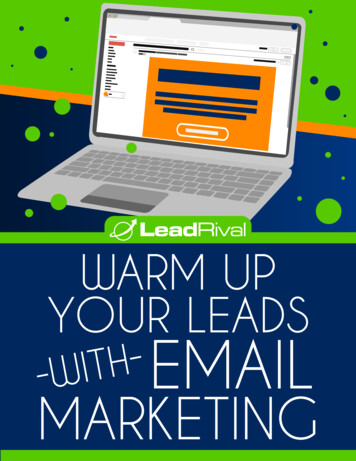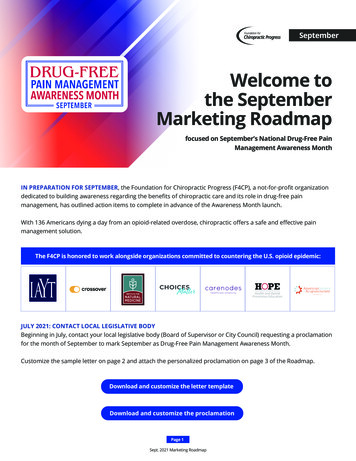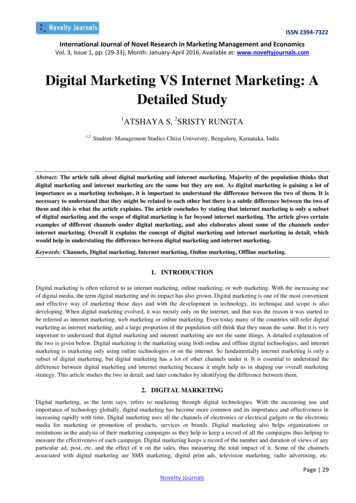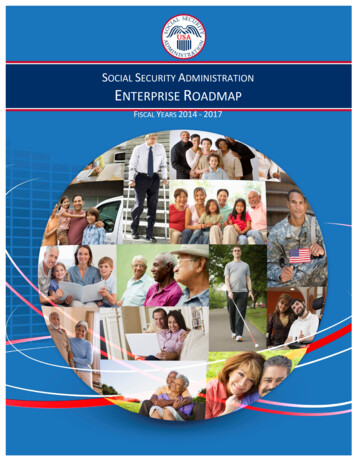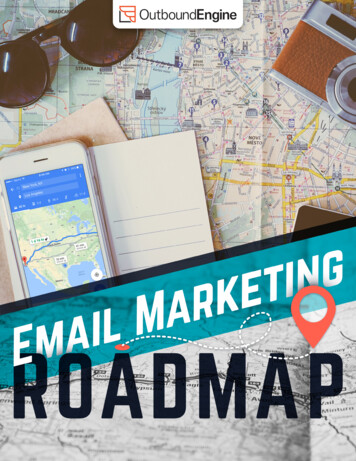
Transcription
EMAIL MARKETING ROADMAPrerouted for 2022Did you know that the world’s first email was sent in 1971? That means that email turned 50 years old in2021. In digital technology years, that’s nearly prehistoric.So why didn’t email go the way of 8-tracks and rotary phones? Why does email continue to not onlysurvive, but thrive as a medium for both communication and marketing? The answer lies in its ubiquityand effectiveness. According to Litmus’ 2021 State of Email survey, 91% of respondents said that emailmarketing is critical to the overall success of their company, up 20 percent from just two years ago.And Statista projects that by 2025, more than 376 billion emails will be sent and received worldwideevery single day.That means email continues to be a crucial channel businesses can use to continually get their namein front of past, present and future clients. This “old reliable” digital channel has survived years ofpredictions about its imminent demise, but the numbers don’t lie: email is still going strong. So ratherthan worrying about whether email is relevant in 2022, businesses should be worrying about how tostand out in their recipients’ crowded inboxes.For many small business owners, email marketing may seem too complicated to be worth the effortto learn. That’s why we created this guide: to show you why email is worth it, and teach you thefundamentals you need to succeed.2
EMAIL MARKETING ROADMAPwhat’s on the route?Hitting the Road. . . . . . . . . . . . . . . . . . . . . . . . . . . . . . . . . . . . . . . . . . . . . . . . . . . . . . . . . . . . . . . . . . . . . . . . . . . . . . . . . . . 47 Benefits of Email Marketing. . . . . . . . . . . . . . . . . . . . . . . . . . . . . . . . . . . . . . . . . . . . . . . . . . . . . . . . . . . . . . . . . . . . . 6SECTION ONE: Best Practices. . . . . . . . . . . . . . . . . . . . . . . . . . . . . . . . . . . . . . . . . . . . . . . . . . . . . . . . . . . . . . . . . . . . . 8The elements of an effective email. . . . . . . . . . . . . . . . . . . . . . . . . . . . . . . . . . . . . . . . . . . . . . . . . . . . . . . . . . . . . 95-Step Checklist to Writing Good Content. . . . . . . . . . . . . . . . . . . . . . . . . . . . . . . . . . . . . . . . . . . . . . . . . . . . . 12Design best practices. . . . . . . . . . . . . . . . . . . . . . . . . . . . . . . . . . . . . . . . . . . . . . . . . . . . . . . . . . . . . . . . . . . . . . . . . 13Scheduling details: creating a consistent schedule and when you should send. . . . . . . . . . . . . . . . . 15How to build an email list. . . . . . . . . . . . . . . . . . . . . . . . . . . . . . . . . . . . . . . . . . . . . . . . . . . . . . . . . . . . . . . . . . . . 16Why you should take advantage of email automation. . . . . . . . . . . . . . . . . . . . . . . . . . . . . . . . . . . . . . . . . . 20SECTION TWO: Turns to Avoid. . . . . . . . . . . . . . . . . . . . . . . . . . . . . . . . . . . . . . . . . . . . . . . . . . . . . . . . . . . . . . . . . . . . . 21Don’t spam. . . . . . . . . . . . . . . . . . . . . . . . . . . . . . . . . . . . . . . . . . . . . . . . . . . . . . . . . . . . . . . . . . . . . . . . . . . . . . . . . . 22Words, phrases and other things to avoid. . . . . . . . . . . . . . . . . . . . . . . . . . . . . . . . . . . . . . . . . . . . . . . . . . . . . 24Why you shouldn’t send email “blasts”. . . . . . . . . . . . . . . . . . . . . . . . . . . . . . . . . . . . . . . . . . . . . . . . . . . . . . . . 25SECTION THREE: The Next Leg: Building Relationships, Improving Your Bottom Line. . . . . . . . . . . . . 26How to build relationships using email marketing. . . . . . . . . . . . . . . . . . . . . . . . . . . . . . . . . . . . . . . . . . . . . . 27How to use email to increase customer retention. . . . . . . . . . . . . . . . . . . . . . . . . . . . . . . . . . . . . . . . . . . . . . 28How to use email for referrals. . . . . . . . . . . . . . . . . . . . . . . . . . . . . . . . . . . . . . . . . . . . . . . . . . . . . . . . . . . . . . . . . 29The Destination. . . . . . . . . . . . . . . . . . . . . . . . . . . . . . . . . . . . . . . . . . . . . . . . . . . . . . . . . . . . . . . . . . . . . . . . . . . . . . . . . . 303
EMAIL MARKETING ROADMAPhitting the road1what is email marketing?In many ways, email marketing is a digital form of direct marketing—a way of reaching many current,past, and potential customers at once. Rather than sending letters, catalogs or flyers, these messagesare sent to inboxes.The primary advantage of email over direct mail is that you can track and measure your success. You cansee how many of your emails were delivered and opened, if links were clicked, and if anyone took action,such as filling out a form or referring a friend.2types of email marketingThe format and approach you take with your email marketing will vary depending on your audience,industry, and goals. Here are some of the more common types of email marketing:product or catalog: These emails focus on specific products/services or a suite of them.newsletters: Sent on a consistent schedule, newsletters can cover many areas. Emails forOutboundEngine customers follow the newsletter format, and they contain helpful, industry-adjacentinformation. Their goal is to keep you top of mind with your customers.campaigns: This could include sales or time-sensitive information. Political campaigns and nonprofitsuse these often for fundraising, voting and other events, like industry parties, that run for specificperiods of time.nurturing: These are time-based emails that are sent to prospects or customers in a predeterminedsequence. Typically sent more frequently than other types of emails, they encourage the recipient to takesteps to move through a funnel or sales cycle.transactional: These are automated, non-marketing emails crucial to a transaction or businessrelationship, like puchase receipts, reminders, account updates, terms of service, etc.4
EMAIL MARKETING ROADMAP3how is email marketing valuable?Email marketing is one of the most cost-effective, high ROI channels you can capitalize on. Considerthat 91 percent of US email users check their inbox at least once a day. That’s approximately 350 millionpeople reading emails every day, which shows the huge potential email has to help your bottom line.Here are a few additional stats to show the real value of email marketing:Email ranked as the No. 1 channel for ROI out of nine marketing channels, beating out SEO, contentmarketing, paid search, and direct marketing.– ECO NS U LTAN CYEmail marketing averages an ROI of 38 for every 1 spent.– HUBSP OT89 percent of marketers say that email serves as their primary channel of lead generation.– MAIL IGENEmail is the preferred source of communication for 74 percent of consumers.– SEND G RI DOn average, companies attribute 22 percent of their total sales to email marketing.– ECO NS U LTAN CY5
EMAIL MARKETING ROADMAP7 BENEFI T S OF EM A IL M A RK E T INGThe big question is, what advantages does email offer compared to other forms of marketing? With evena small budget, email marketing can help you focus on your target audience, find new customers andretain past customers. You can also test messaging, measure your results, and adjust as necessary—workthat is more challenging or expensive to do with other channels.1reach the right audienceThe biggest advantage of email marketing may be that it allows you to communicate with your targetaudience right where they are. People are liable to recycle direct mail flyers and glaze over ads in theirsocial feeds or in the sidebar of a website. However, a well-crafted and effective email is easier to payattention to and absorb.2tracking the success metricsAs a business owner, it’s helpful to know what you’re doing right and what needs to improve. By trackingmetrics like email clicks and conversations that start after they’re sent, you can see what is resonatingwith your audience. With email marketing software, it becomes easy to gather such data by tracking openand click-through rates and conversions. It’s much harder, if not impossible, to track a direct mail piece.3word of mouthWord of mouth remains one the most powerfully effective marketing tools, and email marketing makesit easier for people to refer you and your business. Recipients can forward emails to their friends andfamilies, especially when the content is relevant, interesting, and strong calls to action are used.C O N T I N U E D O N N E X T PAG E . . .6
EMAIL MARKETING ROADMAP7 BENEFI T S OF EM A IL M A RK E T ING4a low-cost effortEmail marketing is one of the most affordable marketing tools and also often takes less time thanprinted pieces. No paper, postage costs, and no mailing time! You can write, test, and send an email inless time than it takes to have a proof reviewed for a flyer.5personalizationDepending on the service you use, email marketing allows you to personalize all communications. Insome cases, in addition to using someone’s name, you can also include their purchasing or behaviorhistory as well. Examples include whether someone took a quiz, answered a survey, or took some otherform of action.6impulse shopping (and forwarding)Email marketing is incredibly useful for taking advantage of impulse shoppers. With a compelling call toaction incorporated into the emails, you can encourage impulse sales and boost contact. Think: a limitedtime offer, or a holiday sale. It’s easy for recipients to respond to your message when they have a clearask and direction. Even better, they can take action wherever they are.7drives organic trafficWhen you send emails, you remind your readers to go to your site and read more. People who have signedup to receive your emails are more engaged with you already, so they are more inclined to like social postsor forward your emails. The more shares your content has, the organic traffic will come your way.7
EMAIL MARKETING ROADMAPSECTION ONEBEST PRACTICESIn this section, we’ll talk about the practices you should follow in youremail marketing, including:1the elements of an effective email2design best practices3scheduling details4how to build an email list5why you should take advantage of email automation8
EMAIL MARKETING ROADMAPTHE ELEMENTS OF ANEFFECTIVE EMAILMaking your email stand out in an inbox is both a science and an art. To motivate people to open, read,and act on your emails, you need to master three email elements: subject lines, content, and calls toaction (CTAs).subject linesYou have three to four seconds to grab someone’s attention with your subject line. Seriously, that’s it!That’s how long it takes for someone to decide whether or not they’ll open your email. How you writeyour subject line is a major factor in someone making the decision to open. Here are a few guidelines tohelp you write them effectively:Be informative but brief so your audience can easily scan their inbox.Communicate something important, valuable or timely to prompt your audience to open the email.Fifty characters is generally a good rule of thumb to follow for subject line length.Consider asking questions, indicating a numbered list, and personalizing your subject line.Try to keep it specific, short and compelling.Avoid using spam trigger words.Pro tip: Make sure the subject line supports the email content.Meaning, if you write a subject line that says, “15 Black Friday Deals You Won’t Believe,” and then inthe email body you ask people to follow your Facebook page to learn more, you will see a sharp drop insubscribers and engagement. People do not like feeling tricked or bait-and-switched.bad subject line exampleAMAZING DEALS! Don’t Miss Out On This CRAZY Sale !!! What Are You Waiting For? Click Now forFree Stuff!good subject line exampleOur 10 Best Deals: Huge Savings on All Holiday Overstock9
EMAIL MARKETING ROADMAPAs technology continues to evolve, so should your strategy when writing subject lines. What works oneyear might not perform as well next year. Some research says subject line length is important, whileothers insist it doesn’t matter. Some say you should avoid spam trigger words, but others say you canuse them cautiously if you already have a good email reputation. These are decisions to be made aftertesting, experience, and careful consideration.It’s good to understand the rules. However, since there’s not always a clear consensus, occasionallystepping outside the lines may surprise you with a great open rate. Be careful when experimenting. Itcan be a tough and slow recovery after your email reputation takes a hit.What about preheaders? A preheader is the preview text that some email clients show before the emailis opened. Many email platforms allow you to customize this text; if you have the option, do it! Just makesure it complements your subject line rather than repeating it.contentIf you’re not writing content that your audience cares about, you won’t hold their attention. Emailcontent should be directly tied to the subject line and written in a short, consistent way that makes yourmessage easy to digest.Good content should focus on your customers. Find out what problems they have and write about them.Learn about their habits and hobbies and pair your expertise with content that will strike a chord withthem. Make sure what you write is serving their interests, not your own agenda.Here are a few content tips:Share information that’s not specifically about your business, but topically adjacent. Forexample, a real estate agent could send emails about home improvement updates that add value toa home. A loan officer could share resources on preventing identity theft or maintaining good credit.Maintain a regular cadence of emails. Sending six emails a week will overwhelm your contacts andwill burn you out, too. Sending an email four times a year isn’t enough to stay top of mind either.Show restraint in your desire to sell or pitch to your email lists. Rather, showcase your expertiseon interesting topics and brand yourself professionally. Your audience should know what you do, butthere’s no need to constantly remind them.10
EMAIL MARKETING ROADMAPcalls to action (ctas)The emails you send to your customers have two goals: the first is to keep you top of mind, and thesecond is to help you get more business. Calls to action help you do the latter by driving recipients totake the next step. They can be as simple and clear as “Get a Demo,” “Sign Up” or “Schedule a Call.”As you’re writing your content, always think about what you want your reader to do. Each email shouldhave a goal. For instance, your newsletter might include the first paragraph or two of a blog post you’vewritten, and the CTA is a link that encourages people to “read more” on your site. If you’re running acontest, your CTA may tell people to “visit my Facebook page to enter.” Whatever goal you choose, makesure your readers can take an action to help you achieve it.Keep in mind that emails are not typically about making an immediate sale, but keeping an opendialogue with your contacts. At OutboundEngine, our customers’ email newsletters include calls toaction like “Refer a friend,” “Get in touch” and “Share this email” so that those who are ready to callupon you for your services have an easy way to do so.It’s important to note that these CTAs are not the point of each email. They’re an element that is alwaysthere so recipients always know how to get in touch when they’re ready.When creating your CTA, ask yourself:What do you want the email recipient to do?Are you making your call to action clear enough that a person quickly scanning your email willunderstand what action they’re supposed to take?What’s in it for them?11
EMAIL MARKETING ROADMAP5-S T EP CHECK LIS T T O WRI T ING GOOD CON T EN T1define strategyGive your newsletters a purpose by defining your strengths and using them to your advantage.Make a list of things that you’re an expert in, professionally and personally.Ask yourself what you want your subscribers to know you for.Focus on the topics that satisfy both categories above.2build personasFigure out what characteristics make up your subscriber base and create content for them.Estimate your subscriber demographics—age, location, interests, etc.Make a list of things that get them excited (including posts or newsletters that have been successfulin the past).Compile a list of your customers’ activities and hobbies.3identify problemsPeople know you for your profession. Give them a reason to stay in touch with you for your expertise andadvice.Make a list of questions that you’re asked most often (they may or may not relate directly to yourprofession).From those questions, make a list of answers.Take their problems and break up the answers into different newsletter ideas.Organize these ideas in a calendar so you have newsletters for the whole year.4create solutionsUse your expertise and your customers’ problems to create newsletters that hit the sweet spot. In short,be their go-to resource.Start answering those questions and problems in your email newsletters.Make them readable, understandable, actionable and shareable.5assess contentBefore sending an email, double-check your template.Is the email all about you or your business? (Most of the time, it shouldn’t be.)Does it help solve a problem or entertain your customers?Is this what you want to be known for?12
EMAIL MARKETING ROADMAPdesign best practicesYour content may be great, but if the design makes it too difficult for readers to act on the CTA, no onewill respond the way you want them to. Email clients have different requirements than web browsers, soHTML emails need to be designed and coded according to a variety of standards. Here are a few bestpractices to ensure that your campaign looks great for each and every one of your recipients.make it mobile friendlyYou can expect roughly half of your recipients to open on a mobile device, so optimization for mobile iscrucial. There are three strategies for mobile friendly email: scalable, fluid, and responsive design.scalable design: Works well on both desktop and mobile without relying on code to makeadjustments. This is usually the easiest strategy to implement. It includes large, touch-screen friendlycalls to action, text that’s readable on all screen sizes and a simple layout that works on all devices(usually a single column).fluid design: Uses sizes based on percentages to make tables and images adjust to the viewer’sscreen size. This approach works better for text-heavy emails.responsive design: Uses CSS media queries to adjust layout, as well as the size of images, text, andbuttons. You can even swap content completely depending on whether the viewer is reading on desktopor mobile. This approach provides the most flexibility but also requires the most technical knowledge.include a text-only versionYour email service provider should provide the functionality to include a separate text-only version,which will be automatically sent to recipients who can’t view HTML emails. You can also give yourrecipients the option to see your email in a web browser in case they can’t or don’t want to view yourmessage in their email client.13
EMAIL MARKETING ROADMAPfavor a clean, simple designSingle-column layouts help reduce visual confusion and make it obvious what the reader should look atin what order. They also look better on smaller screens.make it functionalKeep your main body content area under 600 pixels wide, and stick to web-safe fonts. Avoid JavaScript,attachments and background images.be specificFont families, image sizes, table and cell sizes, and colors (including background colors) need to bespecified. If you don’t, the recipient’s email client will choose for you—and you may not like the result.make it effectiveWhen you use images, focus on those that are relevant and attractive. Keep your branding front andcenter, and make sure your headline–your main point–doesn’t require recipients to have to scroll downto see it.test, then test againTry out your email in as many email clients, browsers and operating systems as possible, includingmobile. This means clicking links and combing for errors many times over. You can also purchase asubscription to a service such as Litmus that will show you previews from every email client at once.try a buttonButtons are a great way to highlight your most important calls to action. Use color wisely so your buttonstands out, but doesn’t disrupt the design. Again, keep in mind that since many email clients blockimages, if your CTA is only available embedded in an image, your recipients may not see it. Make sureyour CTA is visible to everyone by using a CSS button instead of an image-based button.It’s hard to overstate how critical mobile is.The numbers vary, but most stats show about half of all emails are opened on a mobile device. And thispercentage is only expected to grow. Make sure you’re ready for a mobile world as more and more peoplewill read your messages on their phone.14
EMAIL MARKETING ROADMAPSCHEDULING DETAILS:WHEN TO SCHEDULE AND SENDbe consistentFirst of all, you need a consistent schedule. This is where you need to be brutally honest with yourself forthe sake of your business’s success. Evaluate your priorities and obligations to determine what you canreasonably commit to. The optimal frequency to contact your customers is one to four times a month.You can test a higher send frequency, but be conscious of your open and unsubscribe rates. When yourengagement starts to decline, it’s time to re-evaluate your approach. You want to find a balance betweenstaying top of mind and not annoying your recipients.Whatever frequency you decide, be consistent so your contacts know what to expect.effective send times and daysWhen should I send my emails? This is one of the most frequently asked questions and also one of themost debated. Ask ten people what the most effective send times and days are, and it’s possible to getten different answers. Even trusted sources have differing opinions on the topic based on their originalresearch and data sets:Yesware says early mornings before 7 a.m. or evenings after 8 p.m. is best, no matter the day of the week.Kissmetrics says early mornings and weekends, but they point out that those days and times arealso the most likely to get you unsubscribes and bounces.Experian’s benchmark study says that between 4pm and 8pm. is optimal.Wordstream thinks that Thursday from 8 to 9am is best.Hubspot says that Tuesdays at 11am will get the highest response.Needless to say, there are many answers to this question. If you’re looking for a fairly safe bet, tryWednesday afternoons around 2pm. Keep in mind that every person, recipient, and email list is uniquedepending on their personal and professional schedules. Test various days and times to find what worksbest for your audience.15
EMAIL MARKETING ROADMAPhow to build an email listBefore you can market to someone using email, you have to have a list of contacts. Building an email listcan seem challenging at first, but don’t let the task intimidate you. Once you start, it will become secondnature. Here are a few tips to get you started and to improve your current efforts.send to people who have opted inYou should send emails only to people who have opted in to receive communication from you. Thismeans they’ve signed up deliberately and know what they’re agreeing to. We do not recommend buyinglists or using lead generation services due to the CAN-SPAM Act (more on this later).past and prospective clientsIf you already have a contact database, great! That’s your starting point. If not, compile the emails of yourpast customers, prospects and anyone else you would regularly communicate with, like friends, familyand professional contacts. Again, make sure you have an existing relationship for best results.lists, quizzes and surveysThese types of content are popular for gathering email addresses because they are quick and interactive.There are several ways you can do this on your own. Create a list of your favorite industry-specific ormotivational podcasts and share it. Send out a survey asking people what kind of content they’d liketo see you write about or questions they want answered. Make sure that you’re giving your audience agenuine incentive just like you would with other email-gathering options. Don’t snag someone’s emailaddress and then spam them with sales pitches. That’s just bad marketing.16
EMAIL MARKETING ROADMAPyour websiteThis is key. Make sure you’re using high-visibility and high-traffic pages to ask people to opt-in for youremails. Forms should be straightforward so people know what they’re signing up for.Limit sidebars and avoid long scrolls and other distractions that draw attention away from your form.Experiment with calls to action to see which increase your conversion rate. Also make sure, no matterwhat form you use, that a visitor can still navigate your site easily.popupsMentioning popups and popovers is usually met with skepticism and eye rolls, but hear us out! There areplenty of examples out there showing impressive email list growth results from popups.The key to popup success is that it has to be something worth interrupting a visitor. For example, arelated piece of content to the page they are on or a special discount on your product.17
EMAIL MARKETING ROADMAPmaximize your social mediaYou should have a presence on LinkedIn, Facebook and Twitter, and maybe other platforms dependingon what audience you’re targeting. Keep in mind that while you might prefer one social network, thatdoesn’t mean all of your clients share your preferences. Build profiles on as many platforms as you cankeep up-to-date and post often on the ones where your audience spends the most time. Use thosechannels to encourage people to opt in to your email marketing campaigns, and tell them what they willgain by doing so.Add your social media accounts to your email signature and make sure your email address and websiteare prominent on all of your social media accounts. This will allow you to maximize your reach with yourcustomers in as many places as possible.Pro tip: Did you know you can easily export contacts from any email and most social media platforms?Chances are you’ve been building a contact list without even knowing it.linkedinYour LinkedIn connections are a goldmine of email addresses for your database. Even if you have thesecontacts in your database already, it’s always a good idea to export updated information in case peoplehave changed email addresses or jobs. LinkedIn is likely to offer more relevant contacts than othersocial media networks because most of those people are connected with you professionally rather thanpersonally.go paperlessUse email as your go-to correspondence. Not only is this method efficient and convenient and ecofriendly but it also puts you in the position of collecting email addresses from the get-go.embrace the clipboardMake it a regular practice to have a clipboard or a tablet at networking events, trade shows or in thewaiting area of your office. This tried-and-true method is a great way to encourage people to join yourmailing list. Again, be sure to let them know exactly what they stand to gain, whether you’re offeringmarket tips, contests, discounts or just a way to stay in touch.18
EMAIL MARKETING ROADMAPlean on your family & friendsBy including friends and family in your email marketing efforts, you are providing content for them to sharewhen they think of someone who would benefit from your services or want to brag about their friend’sbusiness. You will soon see the power of word-of-mouth.become an internet educatorDon’t underestimate the power of your industry knowledge. Host webinars, publish content to LinkedIn,and hold live Q&As on Facebook or Instagram Live. This is an excellent way to put forth valuableinformation, build relationships and, you guessed it, expand your email contact list!use the power of the askTake the time to go through your contacts. If you are missing an email address, call, text, Facebook, andfind it. Let your clients know you’re sending out a newsletter, and explain how it will benefit them.19
EMAIL MARKETING ROADMAPWHY YOU SHOULD TAKEADVANTAGE OF EMAIL AUTOMATIONWhen someone uses the phrase “email automation,” this generally refers to sending out relevant emails ona timeline of your choosing and scheduling them in advance so you don’t have to remember to hit “send.”Examples include welcome emails that are automatically generated and sent to anyone who signsup for your newsletter, a thank you email after a business transaction or a renewal reminder. Anotherexample could include regular newsletters. While you may write and create these newsletters in advance,automation allows you to schedule and send them whenever you choose.Email automation builds customer relationships by combining the power of customer data, great content,and software. It allows you to have continued presence in your clients’ and prospects’ inboxes withouthaving to do all of the work yourself (or at least being able to schedule it for a time that is more convenientfor you).When you’ve set up an automated email campaign, you don’t think about when you should send thenext email because you’ve already scheduled it, giving you more time to focus on other aspects of yourbusiness.20
EMAIL MARKETING ROADMAPSECTION TWOTURNS TO AVOIDIn Section 1 we covered best practices.This section tells you what you don’t want to do.1don’t spam2words, phrases and other things to avoid3why you shouldn’t send email “blasts”
EMAIL MARKETING ROADMAPdon’t spamSpam is junk mail–unsolicited, unwanted and often a scam. That’s why email providers work hard tokeep those annoying emails out of your inbox. But as any experienced email marketer knows, beingreported as spam is both worrisome and avoidable.If you remember only on
Here are a few additional stats to show the real value of email marketing: Email ranked as the No. 1 channel for ROI out of nine marketing channels, beating out SEO, content marketing, paid search, and direct marketing. - ECONSULTANCY Email marketing averages an ROI of 38 for every 1 spent. - HUBSPOT

